The comparison between classic and modern cinema reveals a rich tapestry of cultural influence, where foundational storytelling techniques from the past continue to shape contemporary narratives. While classic films emphasize traditional character development and archetypes, modern cinema often explores innovative themes and diverse narratives, reflecting the dynamic evolution of societal values and technological progress.
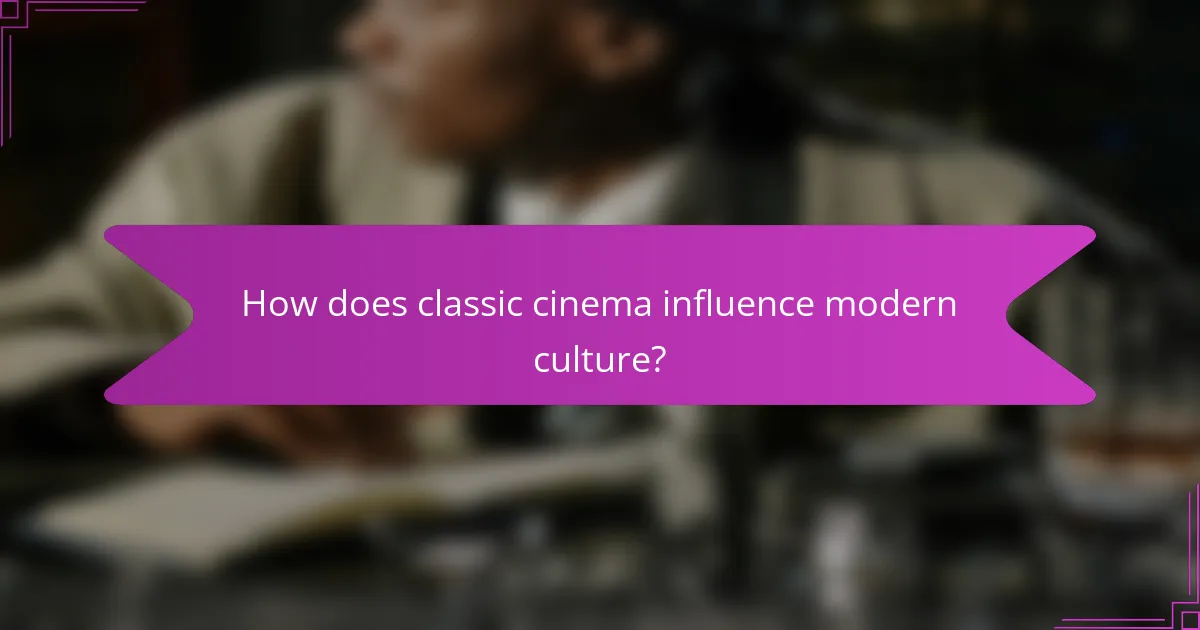
How does classic cinema influence modern culture?
Classic cinema profoundly shapes modern culture by establishing foundational storytelling methods and visual styles that continue to resonate today. Its themes, character archetypes, and narrative structures inform contemporary films, creating a bridge between past and present cinematic experiences.
Timeless storytelling techniques
Classic cinema employs storytelling techniques that remain effective in modern narratives, such as the hero’s journey, character development, and moral dilemmas. These methods engage audiences by creating relatable characters and compelling plots that resonate across generations.
For example, films like “Casablanca” and “Gone with the Wind” utilize conflict and resolution in ways that modern filmmakers still emulate. Understanding these techniques can help contemporary writers craft stories that captivate viewers and evoke emotional responses.
Iconic film styles and aesthetics
The visual styles and aesthetics of classic cinema have left a lasting imprint on modern filmmaking. Techniques such as chiaroscuro lighting, meticulous set design, and innovative camera angles are often referenced in contemporary films to evoke nostalgia or convey specific moods.
Directors like Quentin Tarantino and Wes Anderson frequently draw inspiration from classic films, incorporating vintage styles into their work. This blending of old and new allows filmmakers to create a unique visual language that pays homage to the past while appealing to modern audiences.
Impact on contemporary filmmakers
Many contemporary filmmakers cite classic cinema as a significant influence on their work, shaping their artistic vision and narrative choices. By studying classic films, modern directors can learn valuable lessons about pacing, character arcs, and thematic depth.
For instance, filmmakers such as Martin Scorsese and Christopher Nolan often reference classic films in interviews, highlighting how these influences inform their storytelling techniques. Aspiring filmmakers can benefit from analyzing classic cinema to understand the roots of effective filmmaking and develop their unique voice.
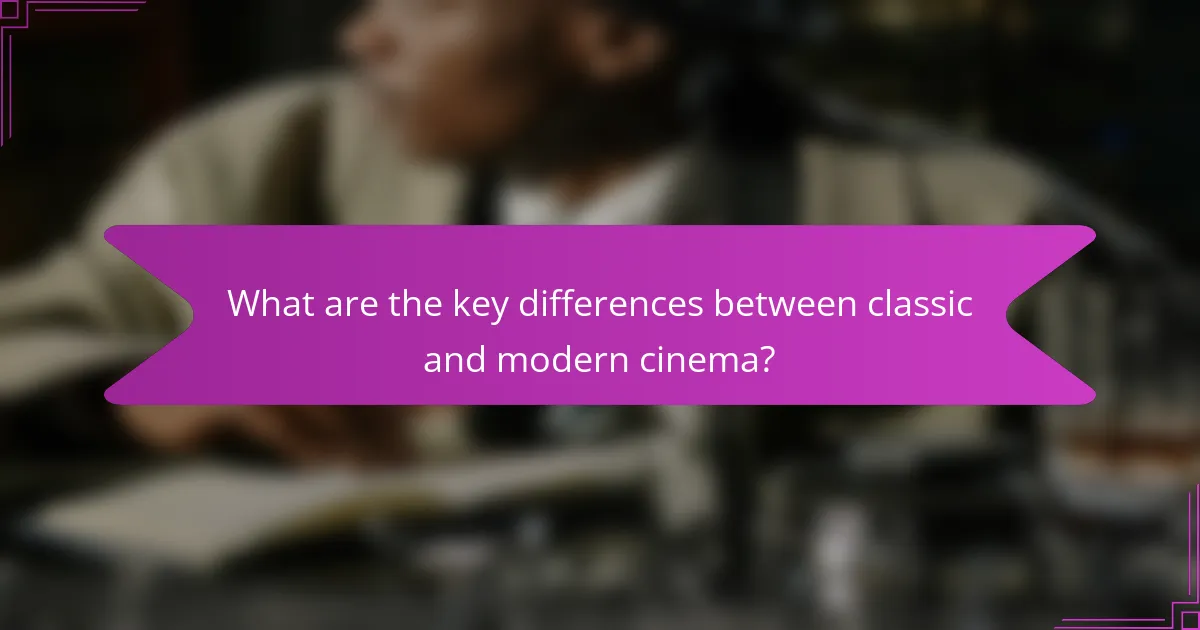
What are the key differences between classic and modern cinema?
Classic cinema typically features traditional storytelling techniques and a focus on character development, while modern cinema often embraces innovative narratives and diverse themes. The evolution in filmmaking styles reflects broader cultural shifts and technological advancements over time.
Narrative structure variations
Classic cinema often adheres to a linear narrative structure, where stories unfold in a straightforward, chronological order. This approach allows for clear character arcs and resolutions, making it accessible to a wide audience.
In contrast, modern cinema frequently experiments with non-linear storytelling, incorporating flashbacks, multiple perspectives, and open-ended conclusions. This complexity can engage viewers more deeply but may also challenge traditional expectations.
Technological advancements
Classic films primarily relied on practical effects, set designs, and traditional film stock, which shaped their aesthetic and storytelling methods. Techniques such as matte painting and model work were common, creating a distinctive visual style.
Modern cinema leverages digital technology, including CGI, high-definition cameras, and advanced editing software. These innovations allow filmmakers to create visually stunning effects and immersive experiences, significantly altering how stories are told and perceived.
Audience engagement methods
Classic cinema often engaged audiences through emotional storytelling and relatable characters, fostering a strong connection with viewers. The focus was on narrative depth and character development, encouraging audiences to invest in the story.
Modern cinema employs various engagement strategies, including interactive marketing, social media campaigns, and immersive experiences like virtual reality. These methods aim to create a community around films, enhancing viewer participation and investment in the cinematic experience.
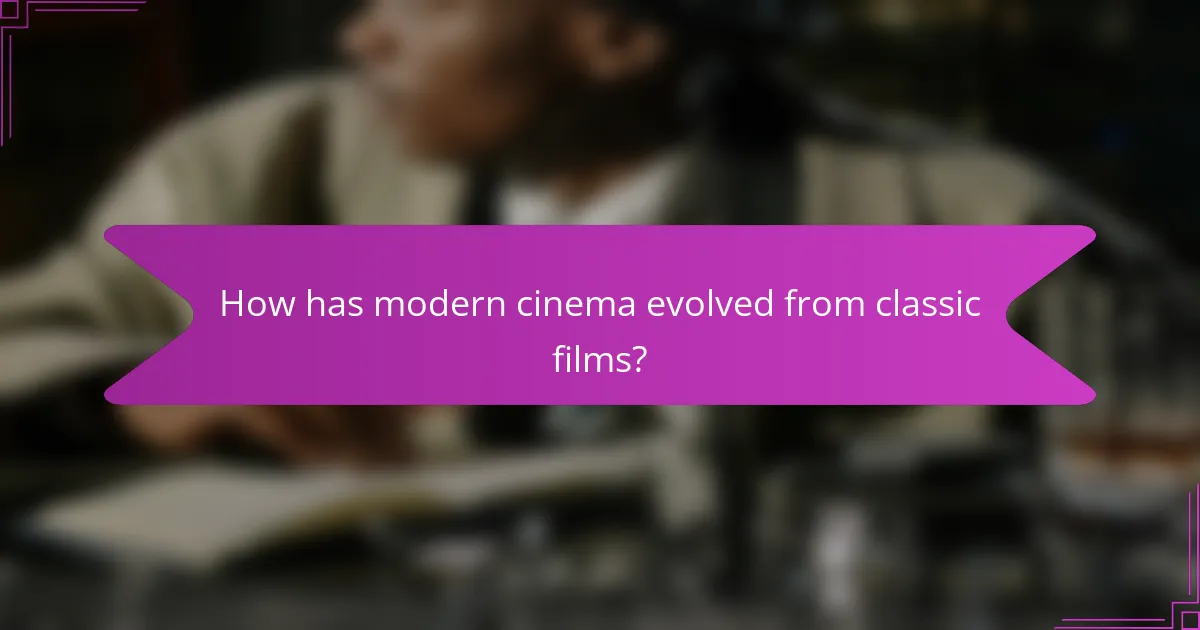
How has modern cinema evolved from classic films?
Modern cinema has evolved significantly from classic films, reflecting changes in societal values, technology, and audience expectations. Key developments include shifts in thematic focus, character complexity, and the emergence of diverse genres that cater to a wider range of viewers.
Shift in thematic focus
Thematic focus in modern cinema often emphasizes contemporary issues such as social justice, mental health, and environmental concerns, diverging from the more traditional narratives found in classic films. While classic films frequently centered on romance, heroism, and moral lessons, modern films tackle complex themes that resonate with current societal challenges. This shift allows filmmakers to engage audiences on deeper levels, reflecting the evolving cultural landscape.
Changes in character development
Character development has become more nuanced in modern cinema, with a focus on flawed, multi-dimensional characters. Unlike the archetypal heroes and villains of classic films, contemporary characters often display a range of emotions and motivations, making them more relatable. This complexity invites viewers to empathize with characters’ struggles, fostering a stronger connection to the narrative.
Emergence of diverse genres
Modern cinema has seen the emergence of diverse genres that cater to various tastes and demographics, expanding beyond the traditional categories of drama, comedy, and action. Genres such as horror-comedy, sci-fi thrillers, and documentary-style narratives have gained popularity, reflecting a broader spectrum of storytelling. This diversification allows filmmakers to experiment with styles and themes, appealing to a wider audience and encouraging innovative cinematic expressions.
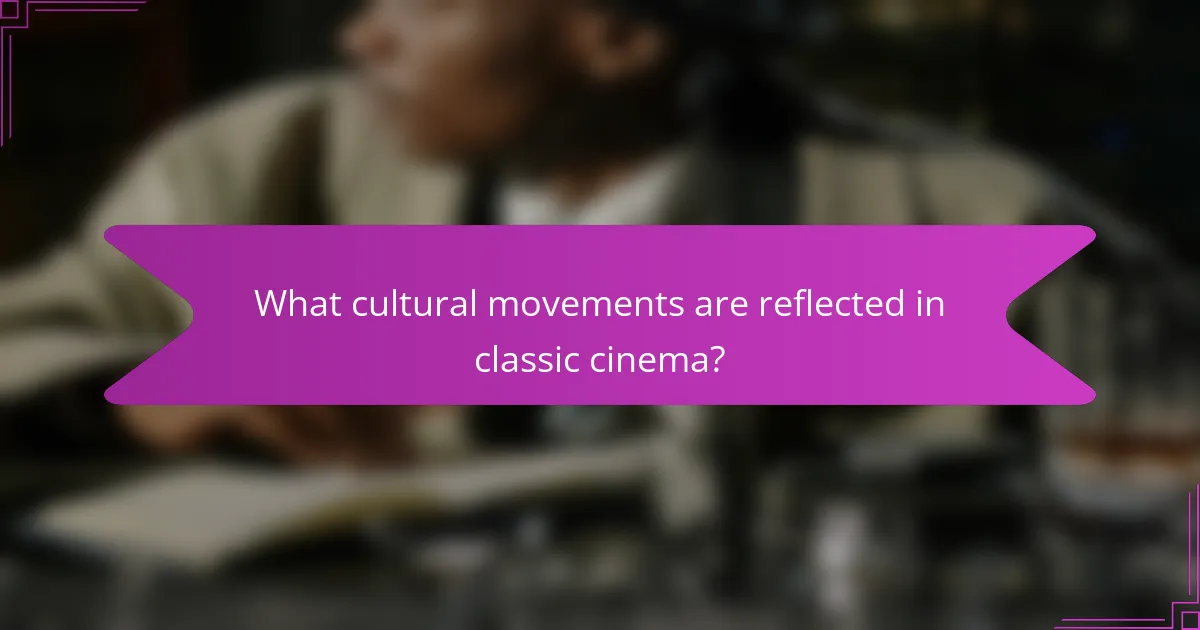
What cultural movements are reflected in classic cinema?
Classic cinema often mirrors significant cultural movements, showcasing the values, struggles, and aspirations of its time. These films serve as historical artifacts that reveal how society viewed itself and its challenges, from the Great Depression to World War II.
Representation of historical events
Classic films frequently depict pivotal historical events, providing audiences with a narrative lens through which to understand their past. For instance, movies like “Gone with the Wind” and “Casablanca” reflect the complexities of war and societal change during their respective eras.
These representations can influence public perception and memory of events, shaping cultural narratives. Filmmakers often take creative liberties, which can lead to dramatized portrayals that emphasize certain themes over others.
Influence of societal norms
Classic cinema is deeply intertwined with the societal norms of its time, often reinforcing or challenging prevailing attitudes. Films from the 1950s, for example, typically reflect conservative values, emphasizing family, gender roles, and social order.
As societal norms evolved, so did cinema, with later films beginning to address issues like civil rights and counterculture. This shift illustrates how cinema can both reflect and influence societal change, acting as a mirror and a catalyst.
Portrayal of gender roles
The portrayal of gender roles in classic cinema often aligns with the expectations of the time, showcasing women primarily as homemakers or romantic interests. Films like “The Philadelphia Story” highlight traditional gender dynamics, where male characters often dominate the narrative.
However, some classic films began to challenge these stereotypes, presenting more complex female characters. This gradual evolution in gender portrayal paved the way for modern cinema to explore diverse and empowered representations of women.
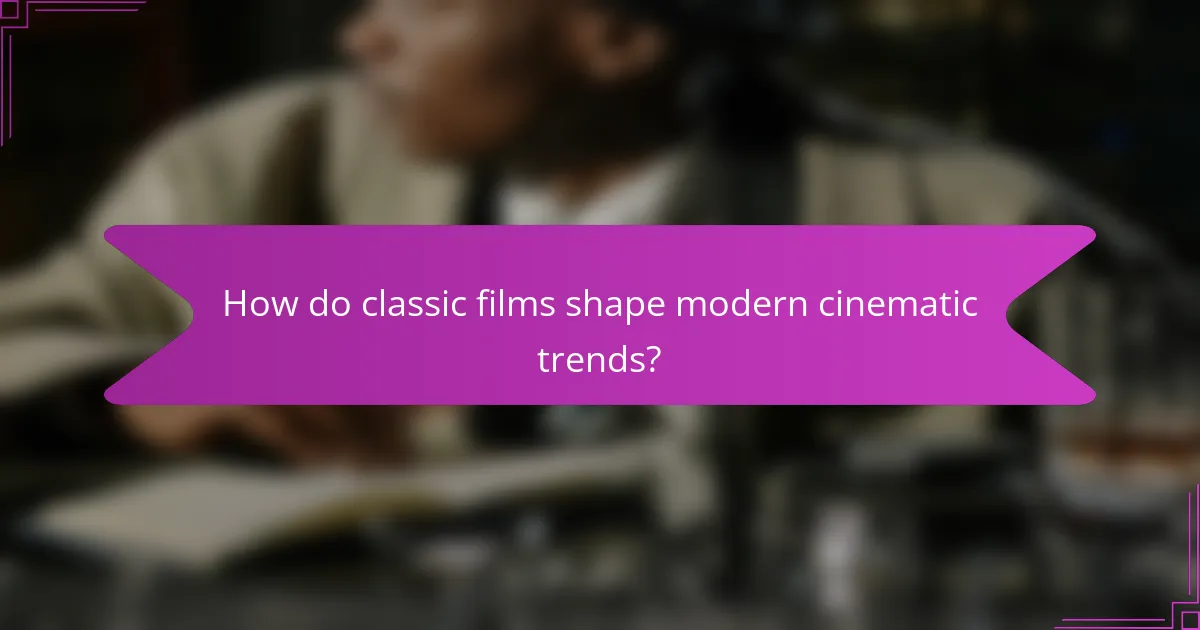
How do classic films shape modern cinematic trends?
Classic films significantly influence modern cinematic trends by establishing foundational storytelling techniques, themes, and stylistic choices that continue to resonate with audiences today. These films serve as a reference point for filmmakers, inspiring new works that often pay homage to or reinterpret classic narratives.
Revival of classic genres
The revival of classic genres, such as film noir, westerns, and musicals, showcases how modern cinema draws inspiration from earlier works. Filmmakers often blend traditional elements with contemporary themes to create fresh narratives that appeal to both nostalgic viewers and new audiences. For instance, recent films like “La La Land” have successfully revived the musical genre while incorporating modern storytelling techniques.
Additionally, the resurgence of interest in classic genres can be seen in streaming platforms, which frequently feature curated collections of classic films. This accessibility allows new generations to discover and appreciate the stylistic choices and storytelling methods that defined these genres.
Influence on modern screenwriting
Classic films have profoundly influenced modern screenwriting by establishing archetypal characters, plot structures, and dialogue styles that continue to be effective today. Screenwriters often reference classic works to understand character development and narrative arcs, ensuring their stories resonate with audiences. For example, the three-act structure, popularized by many classic films, remains a staple in screenwriting courses and industry practices.
Moreover, modern screenwriters frequently incorporate themes from classic cinema, such as love, betrayal, and redemption, into their scripts. This practice not only honors the legacy of classic films but also allows for the exploration of these timeless themes in contemporary contexts, making them relevant for today’s viewers.
